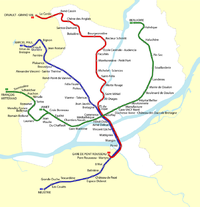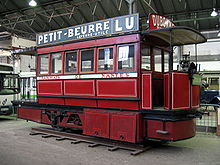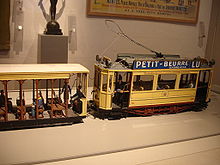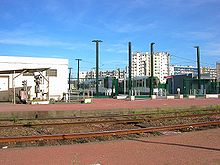- Nantes Tramway
-
Tramway de Nantes 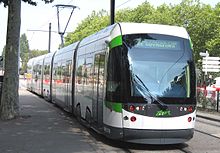
Info Locale Nantes, Pays de la Loire Transit type Tram Number of lines 3 Number of stations 90 Daily ridership 266,300 (2008) Operation Began operation 1985 Operator(s) Semitan Technical Track gauge 1,435 mm (4 ft 8 1⁄2 in) System map The Nantes tramway is a tramway system located around the city of Nantes, France. The first tramway in Nantes opened in 1879 and closed in 1958 due to bombing damage during World War II, while the present tramway was re-introduced to the city in 1985.
The first tramway in Nantes was notable for its use of compressed air propulsion, pioneering this technology. The present tramway is notable as the first 'new generation' tramway to be built in Europe, reversing the trend of tramway closures that had been going on since the middle of the 20th century and becoming the first in a wave of tramways built from scratch in France and the rest of Europe.
The current tramway system is over 40 kilometres of track, and 90 stations. It is operated by Semitan, the operator of Nantes public transport network.
Contents
History
Compressed air trams (1879-1917)
The history of the tramway in Nantes began on 13 December 1879 with the opening of the first line. Service was provided using standard gauge tramcars propelled by compressed air, using the Mekarski system. The cars stored the compressed air in steel cylinders, and were periodically topped up with air and steam (used to heat the compressed air) at a pair of recharging stations. The later Nantes cars operated at 840 psi (5,800 kPa).[1][2]
The first line constructed was just over 6 km (3.7 mi) long and was a mostly level route operating east-west along the quays of the River Loire. The initial fleet comprised 22 trams, 2 locomotives and four open top trailers. A second route, running north-south and crossing both the original route and the River Loire was opened in 1888.[2]
Further extensions, together with a third route along the banks of the River Erdre, brought the length of the system to 39 km (24 mi) by 1910. By then the fleet had grown to 94 trams, 3 locomotives and 10 open top trailers, and was carrying 12 million passengers per year. By this stage compressed air trams were seen as old-fashioned, and it was decided to electrify the system. Replacement began in 1913, and the last compressed air tram ran in 1917.[2]
Nantes compressed air tramcar 22, later renumbered 18 and dating from 1879, still exists and is the only surviving compressed air tram in the world. It is part of the collection at the AMTUIR museum in Paris, but was in Nantes in 1992.[2][3]
Electric trams (1911-1958)
In 1911 the intention to electrify the network was announced by the mayor, Paul Bellamy, but work did not start until just before the outbreak of World War I. By 1915, 8 lines were in service, and work was not completed until the end of 1919. The company standardized its fleet of 100 tramcars, all on Brill trucks with vestibuled platforms. Further extensions were opened, and by 1932 there were 20 lines serving 14 routes. The network was centred on the Place du Commerce, which is today still the centre of Nantes's tramway network.[4]
During World War II, the network was heavily damaged by continued bombing, and several lines were immediately converted to bus operation due to the prohibitive cost of repairs. After the war, tram was seen as being obsolete, noisy and uncomfortable. The decision to replace all tram services by buses was made in 1949, with the last tram running in 1958.[4]
Modern network (1985-present)
By the end of the 1970s, transport in Nantes was heavily biased to the motor car. In an attempt to relieve congestion, the construction of a motorway along the quays of the River Edre was proposed. The destruction of the urban fabric this would have caused resulted in an outcry and the proposal was rejected. Various public transport solutions were investigated, including improved bus or trolleybus services (rejected as having too limited a capacity), and a metro (rejected as too expensive). Finally a tramway was proposed.[5]
At this point in time, the idea of constructing a new tramway was revolutionary. The trend throughout the world had been to close existing tramways rather than open new ones, and only three relatively small tram systems remained in France (the Lille, Marseille and Saint-Étienne systems). In North America the very beginning of a light rail renaissance was just starting to be seen, with the Edmonton Light Rail Transit system opening in 1978, followed by the Calgary C-Train and San Diego Trolley systems in 1981. No significant new tramway system had been built in Europe in many years.[5][6]
Against this background, Nantes's municipal council gathered a team of engineers to discuss the possibility of building a new tramway system. The project was set up on 10 February 1981 and financial details sorted. The government accepted financing 30% of the construction. Alstom was chosen for the construction of twenty tramcars.
The tramway was finally re-opened in January 1985, with a single line connecting Place du Commerce with Haluchère in the north-east of the city. A month later the section from Place du Commerce to Bellevue in the west opened, resulting in a 10.4 km (6.5 mi) line with 22 tram stops. This line, the core of the current line 1, was an immediate success and carried 42,000 passengers daily by the end of the first year. Line 1 was extended by 2.2 km (1.4 mi) and two stops from Haluchère to Beaujoire in April 1989.[6]
The success of line 1 lead to the decision to construct the north-south line 2, which crosses line 1 at Place du Commerce. The line opened from a southern terminus at Trocadière to 50 Otages, just north of the city centre, in September 1992. Subsequent nortward extensions reached Orvault Grand Val two years later.The first section of line 3 opened in August 2000. This shared tracks with line 2 from its southern terminus at Hotel Dieu, south of Place du Commerce, to a point just north of the Place du Commerce stop, from where it ran on its own tracks to Longchamp in the north-west of the city.[6]
An extension at the western end of line 1 took it to François Mitterrand in August 2000, leaving Bellevue at the end of a short branch. In April 2004, line 3 was extended from Longchamp to Sillon de Bretagne. In August 2005, line 2 was extended 2.2 km (1.4 mi) and three stops from Trocadière to Neustrie. In September 2007, a short stub and terminus was constructed off line 2 at Pont Rousseau, and line 2 cut back from Neustrie to there. In compensation, line 3 was extended from Hotel Dieu to Neustrie.[6][7]
Network
The network is now 41.4 km in length.[8]
Line one (François Mitterrand-Beaujoire)
This was the first line to open in 1985; originally running between Bellevue[disambiguation needed
 ] and Haluchère and entirely built on reserved track, following the trackbed of a line of the former tramway network. It serves the Stade de la Beaujoire along with the city's biggest exhibition centre, the railway station of Nantes, and the city's main and largest library. Along with line two, line one is one of the busiest lines on the network as it serves the very heart of the city.
] and Haluchère and entirely built on reserved track, following the trackbed of a line of the former tramway network. It serves the Stade de la Beaujoire along with the city's biggest exhibition centre, the railway station of Nantes, and the city's main and largest library. Along with line two, line one is one of the busiest lines on the network as it serves the very heart of the city.Line two (Gare de Pont Rousseau-Orvault Grand Val)
Extended on 29 August 2005, towards the south, line two transports the most passengers a day in France.[citation needed] At rush hours, the line is always close to capacity, as it serves the campus of the University of Nantes at Petit Port, as well as Hôtel-Dieu, Nantes' main hospital. In September 2007, the line was reduced in length, so that the southern terminus is now located at Pont-Rousseau in Rezé, adjacent to Rezé-Pont-Rousseau railway station.
Line three (Neustrie-Marcel Paul)
Extended in 2007, line three now runs on the former track of southern line 2, towards its last station, Neustrie, near Nantes Atlantique Airport. A shuttle bus links the short distance between the airport and Neustrie, giving easier access to the tramway and the city centre.
Network extensions
A connection between lines one and two is due to open around 2010 on the northern part of the network. The link will run between the station of Haluchère on line one and Recteur Shmitt on line two.
Rolling stock
The fleet is composed of 79 tramcars of two types, the TFS-1 and the Incentro. Both types serve all three routes.[5][7] In 2011, Nantes ordered eight Urbos trams, with four options, from Spanish manufacturers Construcciones y Auxiliar de Ferrocarriles.[9]
TFS-1
Line 1 opened with 20 cars of type TFS-1, this being the original variant of the Alstom TFS design. TFS stands for Tramway Français Standard, and the intention was that this design would become the standard for subsequent French tram systems. However in the end the design was significantly revised for the Grenoble tram system, the second system to open, introducing the low-floor TFS-2 variant. Consequently, only Nantes has ever operated the TFS-1 variant.[5]
As built, the TFS-1 were double-ended, single-articulated 6-axle tramcars with a high floor and steep stepped access from low level boarding platforms. All the tramcars built in this form have since been rebuilt with an added low-floor centre section, thus becoming 8-axle double-articulated cars with a length of 38 m (125 ft). Nantes subsequently bought further TFS-1 trams in this 8-axle configuration. Nantes now has 46 of these trams, built in 4 tranches from 1985 to 1994.[5][7]
Incentro
Unlike most other French tramways, Nantes decided not to use Alstom's successor to the TFS tramcar, the Citadis. Instead, in 1997, Nantes became the first city to order a fleet of trams to the Adtranz (now Bombardier Transportation) Incentro design. This modular design is made up of cab, powered and suspended sections, and is 100% low floor. The trams built for Nantes are double-ended and consist of five sections, with a length of 36.4 m (119 ft). Nantes now has 33 of these trams.[5][7]
Operation
Operator
The line is operated by Semitan, known as Tan for short. Semitan is responsible for the whole public transport network throughout the Nantes Metropole, and the Metropole has a majority shareholding in the company.[5][7]
The transport group Transdev, which is also involved in the operation of several other tram systems, including the Grenoble, Montpellier, Nottingham and Strasbourg systems, has a minority share holding in Semitan. This allows for exchange of information and assistance between these systems. As an example, the tram drivers for Montpellier were trained at Nantes.[5][7]
Ticketing
The transport network in Nantes uses paper tickets and passes. There are no "travel zones", as a ticket or pass gives access everywhere on the network in greater Nantes. The basic tickets and passes can be used on most forms of public transport in the city, including trams, the BusWay, local buses, Navibus, and suburban trains. The Navette Tan Air airport express bus has its own (more expensive) tickets, but these are also accepted on trams and other modes.
Tickets are not sold on trams, but ticket machines can be found at every tram stop, and tickets must be purchased before boarding the tram. There are also a few staffed ticket offices in the centre of Nantes, opening for limited periods only.
Traffic
In 2007, 63.5 million journeys were made on the tram system, where a journey is defined as a single boarding on a single vehicle. Of these 27.6 million were on line 1, 24.1 million on line 2 and 11.8 million on line 3. On a typical weekday during the school term in 2007, approximately 266,000 journeys were made on the tramway, with 41% on line 1, 32% on line 2 and 27% on line 3.[7]
In providing this service, the cumulative distance travelled by the tram fleet in 2007 was approximately 4.5 million kilometers.[7]
Hours of operation
Trams on the network begin operating around 4 a.m., running until around 1 a.m. on weekdays and Sundays and until 3 a.m. on Saturdays.
See also
- Transportation in Nantes
- Trams in France
- List of town tramway systems in France
References
- ^ "Compressed-Air Propulsion". The Museum of RetroTechnology. http://www.aqpl43.dsl.pipex.com/MUSEUM/TRANSPORT/comprair/comprair.htm. Retrieved 2008-08-27.
- ^ a b c d Prentice, John. "Compressed Air Trams". John R. Prentice. http://tramwayinfo.com/tramways/Articles/Compair2.htm. Retrieved 2008-08-27.
- ^ "Nantes - Tramway - Automotrice Mékarski à air comprimé n° 22 (1879)" (in French). AMTUIR. 2007-10-04. http://amtuir.org/01_musee/collection/fiches_tv_tm/fiche_nantes_tramway_mekarski_22.htm. Retrieved 2008-08-27.
- ^ a b "Histoire des transports en commun de Nantes" (in French). Wikipedia France. 2008-08-21. http://fr.wikipedia.org/w/index.php?title=Histoire_des_transports_en_commun_de_Nantes&oldid=32613591. Retrieved 2008-08-27.
- ^ a b c d e f g h Wansbeek, C.J. (January 2001). "Nantes expansion". Tramways & Urban Transit (Ian Allan Ltd / Light Rail Transit Association). http://www.lrta.info/articles/art0101.html. Retrieved 2008-08-27.
- ^ a b c d Haydock, David (April 2006). "France's tramway boom". Today's Railways (Platform 5 Publishing Ltd): pp. 20–27.
- ^ a b c d e f g h "Key Figures 2007" (pdf). Semitan. http://www.tan.fr/servlet/com.univ.utils.LectureFichierJoint?CODE=1210688510071&LANGUE=0. Retrieved 2008-08-28.
- ^ "Le tramway: toujours plus loin" (in French). Nantes Métropole. http://www.nantesmetropole.fr/1182353148130/0/fiche___article/. Retrieved 2008-03-06.
- ^ "CAF wins Urbos tram contracts". Railway Gazette. 2011-01-05. http://www.railwaygazette.com/nc/news/single-view/view/caf-wins-urbos-tram-contracts.html. Retrieved 2011-01-06.
Bibliography
- Le Tramway Nantais; SEMITAN, 1986. (in French)
External links
- (French) Semitan official website
Urban guided transit systems in France Métros PresentTramways PresentPlannedFormerAvranches · Bordeaux · Cannes · Caen · Grenoble · Deauville · Fontainebleau · Le Havre · Lyon · Nantes · Nice et Littoral · Paris · Rouen · Saint-Romain-de-Colbosc · Strasbourg · Valenciennes · VersaillesGuided buses PresentPlannedDouai · ParisUrban funiculars PresentFormerBesançonUrban cable cars PresentGrenoblePeople movers PresentSee also: Transport in France, List of railways in France, Trams in France, and Railways in FranceCategories:- Transport in Nantes
- Tram transport in France
Wikimedia Foundation. 2010.

